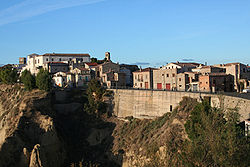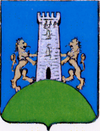Aliano
| Aliano | ||
|---|---|---|
| Comune | ||
| Comune di Aliano | ||
 |
||
|
||
| Location of Aliano in Italy | ||
| Coordinates: 40°19′N 16°14′E / 40.317°N 16.233°E | ||
| Country | Italy | |
| Region | Basilicata | |
| Province / Metropolitan city | Matera (MT) | |
| Frazioni | Alianello | |
| Area | ||
| • Total | 96 km2 (37 sq mi) | |
| Elevation | 498 m (1,634 ft) | |
| Population (December 2008) | ||
| • Total | 1,151 | |
| • Density | 12/km2 (31/sq mi) | |
| Demonym(s) | Alianesi | |
| Time zone | CET (UTC+1) | |
| • Summer (DST) | CEST (UTC+2) | |
| Postal code | 75010 | |
| Dialing code | 0835 | |
| Patron saint | San Luigi Gonzaga | |
| Saint day | 21 Giugno | |
| Website | www.aliano.it | |
Aliano is a town and comune in the province of Matera and is located about 90 kilometres (56 mi) from Matera, in the Southern Italian region of Basilicata.
Aliano is probably most famous for being the inspiration for the fictional town of Gagliano in Carlo Levi's book Christ Stopped at Eboli (Italian: Cristo si è fermato a Eboli). Published in 1945, it gives giving an account of his exile in 1935–36 in Aliano.
Like many towns in rural Italy it has suffered from migration to the cities and overseas where employment opportunities are better.
Aliano is located atop "calanchi", which are deforested, sandy soiled, rocky hills. Over the town's history, many homes were lost to landslide resulting from deforestation. In 1980 an earthquake shook the region destroyed or made uninhabitable many of the town's historic homes. Recent funding, partly from the European Union, has made renovations possible, and parts of the town's historic center are once again inhabitable.
Aliano has its own dialect, "Alianese", and the population keep many old traditions. One particular example is that, during Carnevale (a catholic festival that takes place a few weeks before Easter) village men, dressed in paper mache masks, hats covered with streamers, wearing long underwear and cow bells, march down the town's main street, throwing flour at gathered crowds and making grunting noises.
Some believe that the significance of the custom was to exorcise evil spirits prior to lent.
Another interesting tradition is the use of architecture to ward off the evil eye, the "malocchio". Many of the town's older homes, including one in the town's historic square called casa con gli occhi ("house with eyes") are formed with two forward windows and a staircase leading from the ground up to the home's main floor. (The ground floor was probably stables for animals.) The combination of stairs and windows make the home look like a face. When lit from the inside, the windows may look like burning eyes, enough to scare away any bad spirits.
Loss of population is a major problem in Aliano and other similarly sized towns in the poor regions of southern Italy. Lack of opportunity, fertile land (if people wish to take up agriculture) and a decrease in interest in continuing the farm life of one's parents are two major reasons for population loss.A higher percentage of young people from the South of Italy complete a university education than their peers in the North due to unemployment situation. Professional jobs are few in southern Italian cities, thus numerous of the village's most promising young people move their families to the big industrial cities of the North, especially Milan and Bologna.
...
Wikipedia


